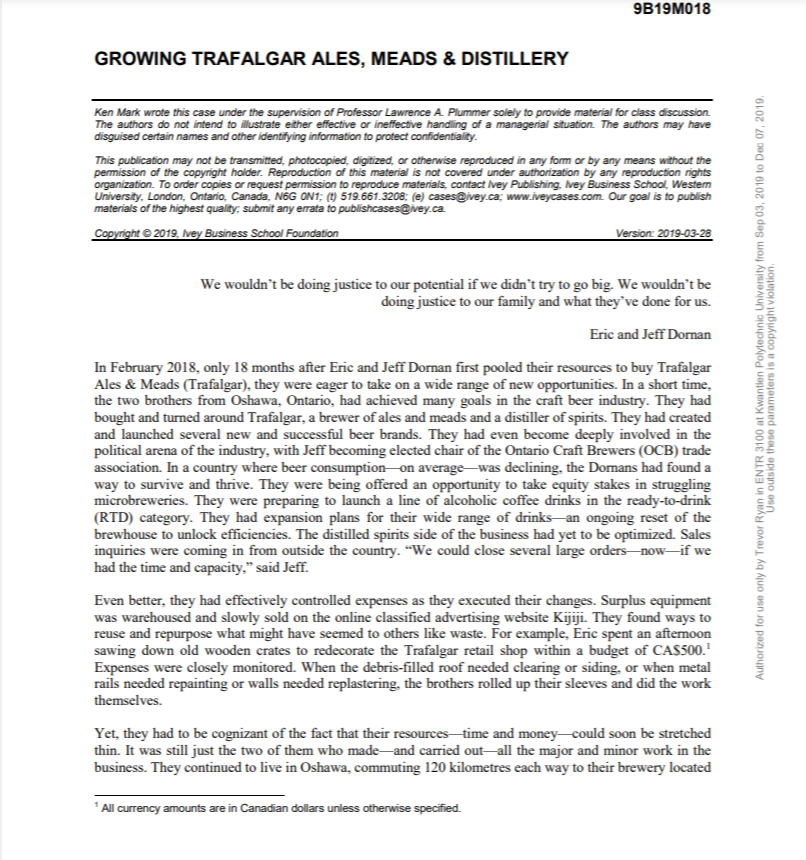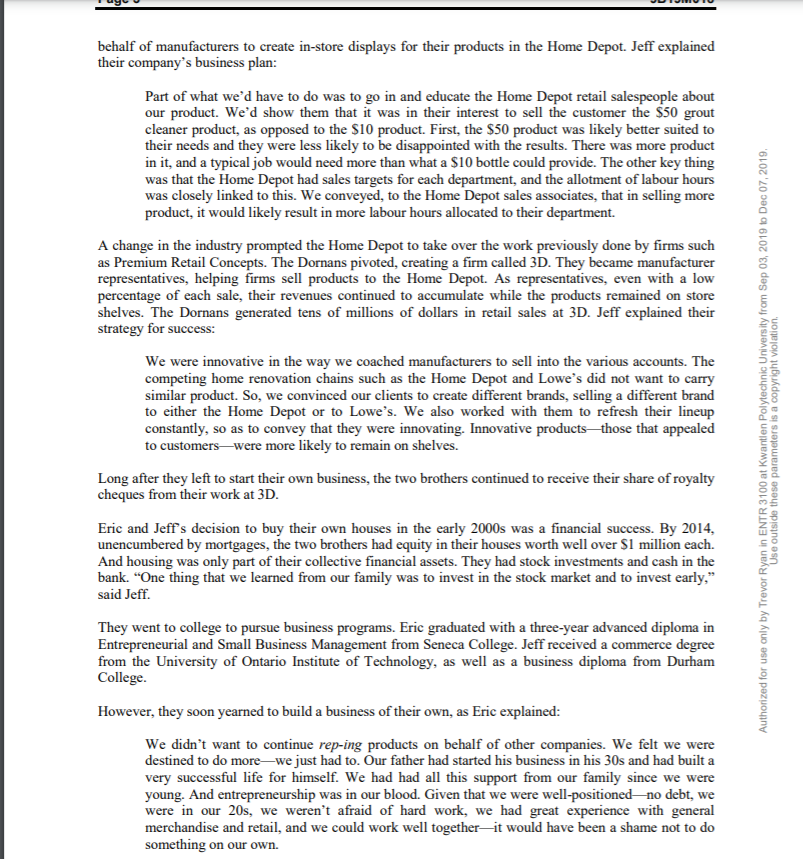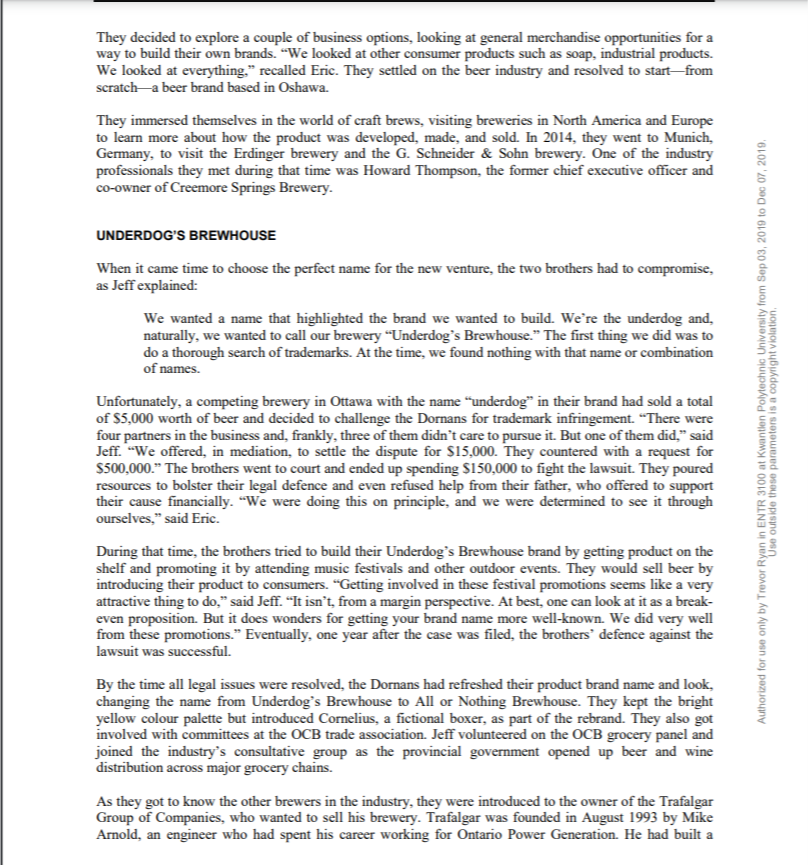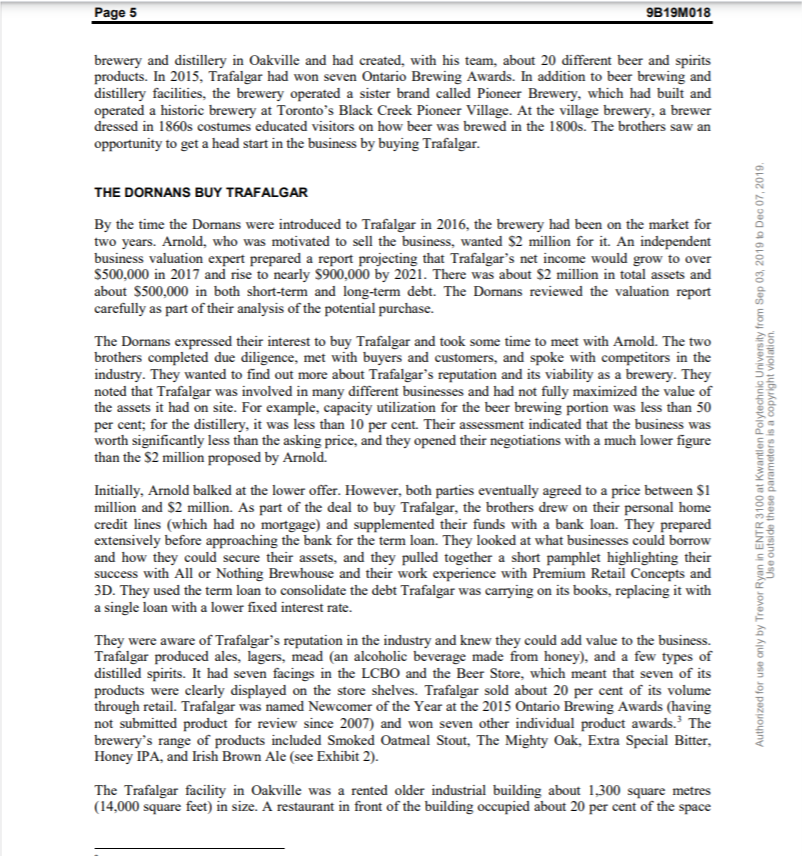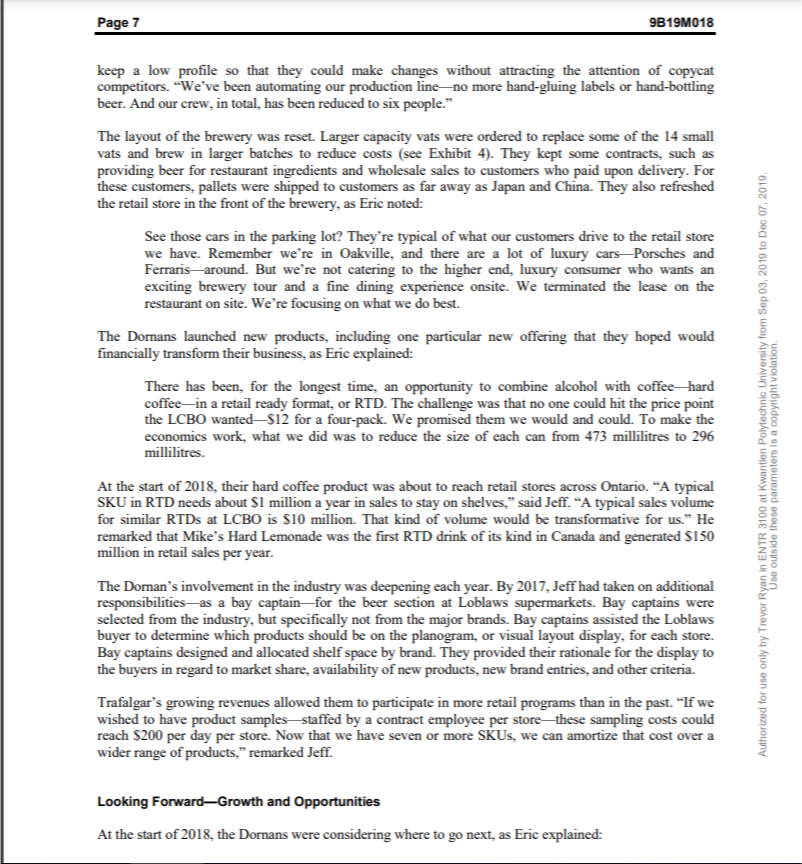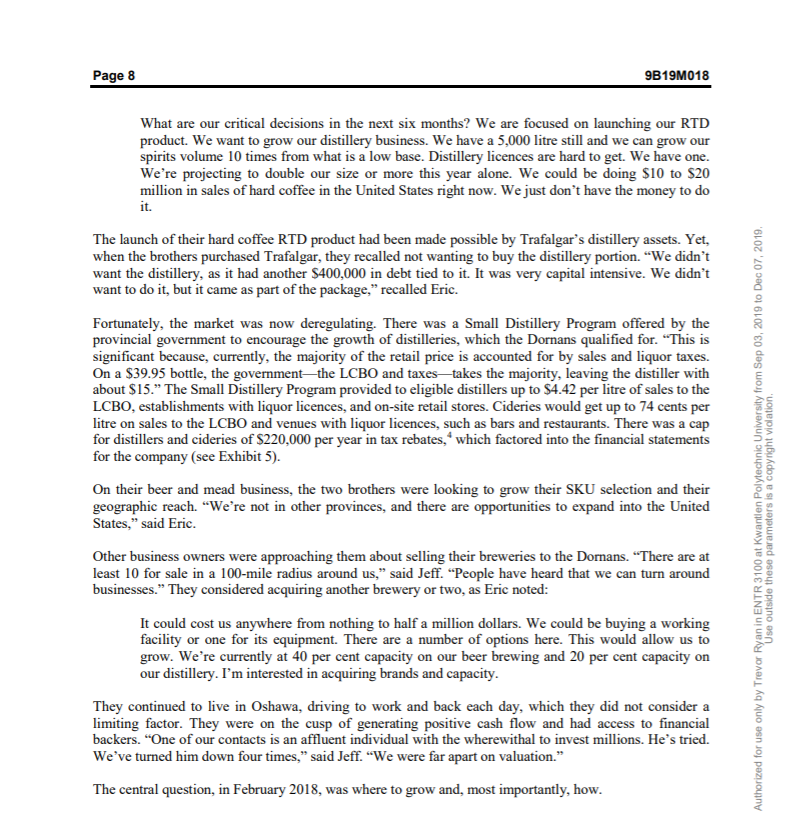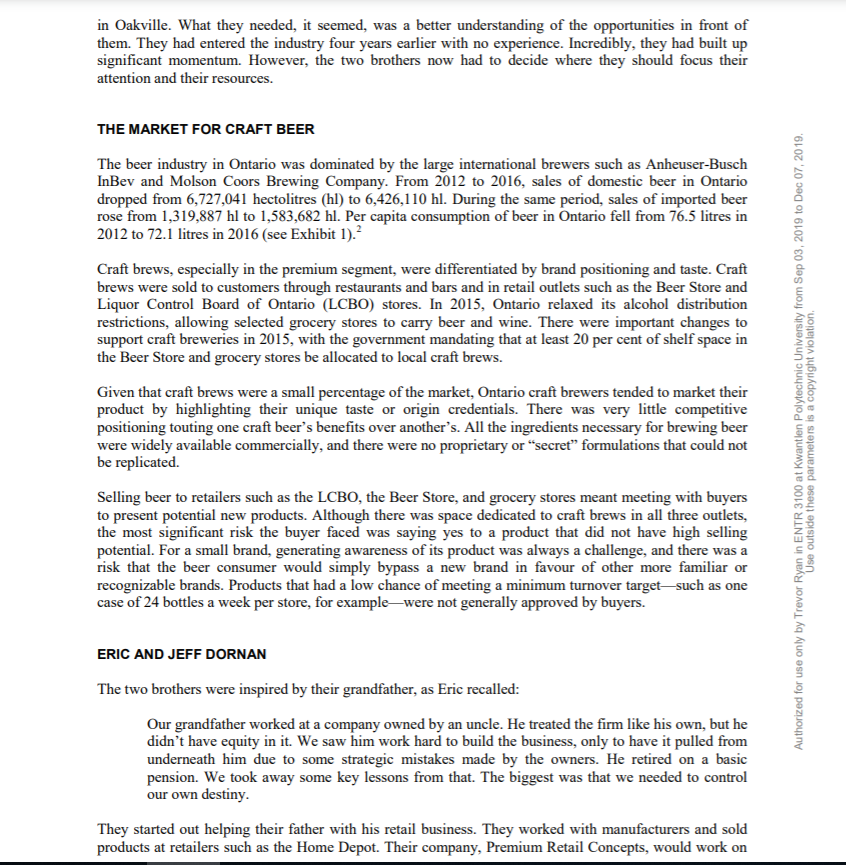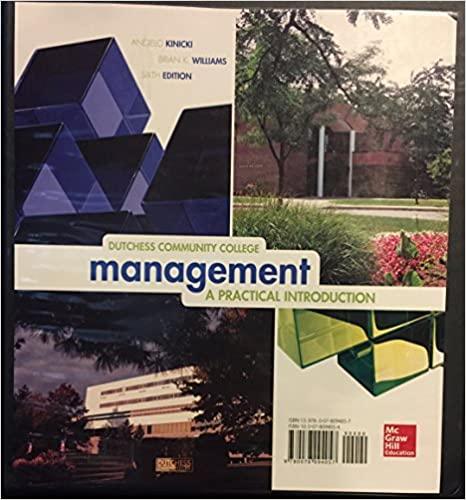what is the SWOT analysis of the given case(Growing Trafalgar Ales, Meads and amp,)
9B19M018 GROWING TRAFALGAR ALES, MEADS & DISTILLERY Ken Mark wrote this case under the supervision of Professor Lawrence A. Plummer solely to provide material for class discussion. The authors do not intend to illustrate either effective or ineffective handling of a managerial situation. The authors may have disguised certain names and other identifying information to protect This publication may not be transmitted, photocopied, digitized, or otherwise reproduced in any form or by any means without the permission of the copyright holder. Reproduction of this material is not covered under authorization by any reproduction rights organization. To order copies or request permission to reproduce materials, contact Ivey Publishing, Ivey Business School, Western University, London, Ontario, Canada, NGG ON1; (1) 519.661.3208; (e) cases@ivey.ca; www.iveycases.com. Our goal is to publish materials of the highest quality, submit any errata to publishcase s@ivey.ca. Copyright @ 2019. Ivey Business School Foundation Version: 2019-03-28 00 at Kwantien Polytechnic University from Sep 03, 2019 to Dec 07, 2019. We wouldn't be doing justice to our potential if we didn't try to go big. We wouldn't be doing justice to our family and what they've done for us. Eric and Jeff Dornan In February 2018, only 18 months after Eric and Jeff Dornan first pooled their resources to buy Trafalgar Ales & Meads (Trafalgar), they were eager to take on a wide range of new opportunities. In a short time, se outside these parameters is a copyright violation the two brothers from Oshawa, Ontario, had achieved many goals in the craft beer industry. They had bought and turned around Trafalgar, a brewer of ales and meads and a distiller of spirits. They had created and launched several new and successful beer brands. They had even become deeply involved in the political arena of the industry, with Jeff becoming elected chair of the Ontario Craft Brewers (OCB) trade association. In a country where beer consumption-on average-was declining, the Dornans had found a way to survive and thrive. They were being offered an opportunity to take equity stakes in struggling microbreweries. They were preparing to launch a line of alcoholic coffee drinks in the ready-to-drink (RTD) category. They had expansion plans for their wide range of drinks-an ongoing reset of the brewhouse to unlock efficiencies. The distilled spirits side of the business had yet to be optimized. Sales inquiries were coming in from outside the country. "We could close several large orders-now-if we had the time and capacity," said Jeff. Authorized for use only by Trevor Ryan in EN Even better, they had effectively controlled expenses as they executed their changes. Surplus equipment was warehoused and slowly sold on the online classified advertising website Kijiji. They found ways to reuse and repurpose what might have seemed to others like waste. For example, Eric spent an afternoon sawing down old wooden crates to redecorate the Trafalgar retail shop within a budget of CA$500." Expenses were closely monitored. When the debris-filled roof needed clearing or siding, or when metal rails needed repainting or walls needed replastering, the brothers rolled up their sleeves and did the work themselves. Yet, they had to be cognizant of the fact that their resources-time and money-could soon be stretched thin. It was still just the two of them who made-and carried out-all the major and minor work in the business. They continued to live in Oshawa, commuting 120 kilometres each way to their brewery located All currency amounts are in Canadian dollars unless otherwise specified.behalf of manufacturers to create in-store displays for their products in the Home Depot. Jeff explained their company's business plan: Part of what we'd have to do was to go in and educate the Home Depot retail salespeople about our product. We'd show them that it was in their interest to sell the customer the $50 grout cleaner product, as opposed to the $10 product. First, the $50 product was likely better suited to their needs and they were less likely to be disappointed with the results. There was more product in it, and a typical job would need more than what a $10 bottle could provide. The other key thing was that the Home Depot had sales targets for each department, and the allotment of labour hours was closely linked to this. We conveyed, to the Home Depot sales associates, that in selling more product, it would likely result in more labour hours allocated to their department. A change in the industry prompted the Home Depot to take over the work previously done by firms such as Premium Retail Concepts. The Dornans pivoted, creating a firm called 3D. They became manufacturer representatives, helping firms sell products to the Home Depot. As representatives, even with a low percentage of each sale, their revenues continued to accumulate while the products remained on store shelves. The Dornans generated tens of millions of dollars in retail sales at 3D. Jeff explained their strategy for success: We were innovative in the way we coached manufacturers to sell into the various accounts. The competing home renovation chains such as the Home Depot and Lowe's did not want to carry similar product. So, we convinced our clients to create different brands, selling a different brand to either the Home Depot or to Lowe's. We also worked with them to refresh their lineup constantly, so as to convey that they were innovating. Innovative products-those that appealed Authorized for use only by Trevor Ryan in ENTR 3100 at Kwantlen Polytechnic University from Sep 03, 2019 to Dec 07, 2019. to customers-were more likely to remain on shelves. Use outside these parameters is a copyright violation Long after they left to start their own business, the two brothers continued to receive their share of royalty cheques from their work at 3D. Eric and Jeff's decision to buy their own houses in the early 2000s was a financial success. By 2014, unencumbered by mortgages, the two brothers had equity in their houses worth well over $1 million each. And housing was only part of their collective financial assets. They had stock investments and cash in the bank. "One thing that we learned from our family was to invest in the stock market and to invest early," said Jeff. They went to college to pursue business programs. Eric graduated with a three-year advanced diploma in Entrepreneurial and Small Business Management from Seneca College. Jeff received a commerce degree from the University of Ontario Institute of Technology, as well as a business diploma from Durham College. However, they soon yearned to build a business of their own, as Eric explained: We didn't want to continue rep-ing products on behalf of other companies. We felt we were destined to do more-we just had to. Our father had started his business in his 30s and had built a very successful life for himself. We had had all this support from our family since we were young. And entrepreneurship was in our blood. Given that we were well-positioned-no debt, we were in our 20s, we weren't afraid of hard work, we had great experience with general merchandise and retail, and we could work well together-it would have been a shame not to do something on our own.They decided to explore a couple of business options, looking at general merchandise opportunities for a way to build their own brands. "We looked at other consumer products such as soap, industrial products. We looked at everything," recalled Eric. They settled on the beer industry and resolved to start-from scratch-a beer brand based in Oshawa. They immersed themselves in the world of craft brews, visiting breweries in North America and Europe to learn more about how the product was developed, made, and sold. In 2014, they went to Munich, Germany, to visit the Erdinger brewery and the G. Schneider & Sohn brewery. One of the industry professionals they met during that time was Howard Thompson, the former chief executive officer and co-owner of Creemore Springs Brewery. UNDERDOG'S BREWHOUSE When it came time to choose the perfect name for the new venture, the two brothers had to compromise, as Jeff explained: We wanted a name that highlighted the brand we wanted to build. We're the underdog and, 3100 at Kwantien Polytechnic University from Sep 03, 2019 to Dec 07, 2019. naturally, we wanted to call our brewery "Underdog's Brewhouse." The first thing we did was to do a thorough search of trademarks. At the time, we found nothing with that name or combination of names. Unfortunately, a competing brewery in Ottawa with the name "underdog" in their brand had sold a total hese parameters is a copyright violation of $5,000 worth of beer and decided to challenge the Dornans for trademark infringement. "There were four partners in the business and, frankly, three of them didn't care to pursue it. But one of them did," said Jeff. "We offered, in mediation, to settle the dispute for $15,000. They countered with a request for $500,000." The brothers went to court and ended up spending $150,000 to fight the lawsuit. They poured resources to bolster their legal defence and even refused help from their father, who offered to support their cause financially. "We were doing this on principle, and we were determined to see it through ourselves," said Eric. During that time, the brothers tried to build their Underdog's Brewhouse brand by getting product on the shelf and promoting it by attending music festivals and other outdoor events. They would sell beer by introducing their product to consumers. "Getting involved in these festival promotions seems like a very attractive thing to do," said Jeff. "It isn't, from a margin perspective. At best, one can look at it as a break- even proposition. But it does wonders for getting your brand name more well-known. We did very well Authorized for use only by Trevor Ryan in E from these promotions." Eventually, one year after the case was filed, the brothers' defence against the lawsuit was successful. By the time all legal issues were resolved, the Dornans had refreshed their product brand name and look, changing the name from Underdog's Brewhouse to All or Nothing Brewhouse. They kept the bright yellow colour palette but introduced Cornelius, a fictional boxer, as part of the rebrand. They also got involved with committees at the OCB trade association. Jeff volunteered on the OCB grocery panel and joined the industry's consultative group as the provincial government opened up beer and wine distribution across major grocery chains. As they got to know the other brewers in the industry, they were introduced to the owner of the Trafalgar Group of Companies, who wanted to sell his brewery. Trafalgar was founded in August 1993 by Mike Arnold, an engineer who had spent his career working for Ontario Power Generation. He had built aPage 5 9B19M018 brewery and distillery in Oakville and had created, with his team, about 20 different beer and spirits products. In 2015, Trafalgar had won seven Ontario Brewing Awards. In addition to beer brewing and distillery facilities, the brewery operated a sister brand called Pioneer Brewery, which had built and operated a historic brewery at Toronto's Black Creek Pioneer Village. At the village brewery, a brewer dressed in 1860s costumes educated visitors on how beer was brewed in the 1800s. The brothers saw an opportunity to get a head start in the business by buying Trafalgar. THE DORNANS BUY TRAFALGAR By the time the Dornans were introduced to Trafalgar in 2016, the brewery had been on the market for two years. Arnold, who was motivated to sell the business, wanted $2 million for it. An independent business valuation expert prepared a report projecting that Trafalgar's net income would grow to over $500,000 in 2017 and rise to nearly $900,000 by 2021. There was about $2 million in total assets and about $500,000 in both short-term and long-term debt. The Dornans reviewed the valuation report carefully as part of their analysis of the potential purchase. 00 at Kwantlen Polytechnic University from Sep 03, 2019 to Dec 07, 2019. The Dornans expressed their interest to buy Trafalgar and took some time to meet with Amold. The two brothers completed due diligence, met with buyers and customers, and spoke with competitors in the industry. They wanted to find out more about Trafalgar's reputation and its viability as a brewery. They noted that Trafalgar was involved in many different businesses and had not fully maximized the value of the assets it had on site. For example, capacity utilization for the beer brewing portion was less than 50 per cent; for the distillery, it was less than 10 per cent. Their assessment indicated that the business was worth significantly less than the asking price, and they opened their negotiations with a much lower figure than the $2 million proposed by Arnold. Use outside these parameters is a copyright violation Initially, Arnold balked at the lower offer. However, both parties eventually agreed to a price between $1 million and $2 million. As part of the deal to buy Trafalgar, the brothers drew on their personal home R 3100 a credit lines (which had no mortgage) and supplemented their funds with a bank loan. They prepared extensively before approaching the bank for the term loan. They looked at what businesses could borrow and how they could secure their assets, and they pulled together a short pamphlet highlighting their success with All or Nothing Brewhouse and their work experience with Premium Retail Concepts and 3D. They used the term loan to consolidate the debt Trafalgar was carrying on its books, replacing it with a single loan with a lower fixed interest rate. They were aware of Trafalgar's reputation in the industry and knew they could add value to the business. Authorized for use only by Trevor Ryan in E Trafalgar produced ales, lagers, mead (an alcoholic beverage made from honey), and a few types of distilled spirits. It had seven facings in the LCBO and the Beer Store, which meant that seven of its products were clearly displayed on the store shelves. Trafalgar sold about 20 per cent of its volume through retail. Trafalgar was named Newcomer of the Year at the 2015 Ontario Brewing Awards (having not submitted product for review since 2007) and won seven other individual product awards. The brewery's range of products included Smoked Oatmeal Stout, The Mighty Oak, Extra Special Bitter, Honey IPA, and Irish Brown Ale (see Exhibit 2). The Trafalgar facility in Oakville was a rented older industrial building about 1,300 square metres (14,000 square feet) in size. A restaurant in front of the building occupied about 20 per cent of the spacePage 6 9B19M018 and the restaurant owner subleased the space from Trafalgar for $1,500 per month. The brewery produced about 1,600 hl in beer sales per year. There was a lot of labour-intensive work done at Trafalgar. The operation was set up loosely in a job shop fashion, with brewing vats in various parts of the brewery. Moving product often required employees to cross large sections of the brewery, winding their way around equipment. Many of the vats were much smaller-about one fifth-than the industry standard, which allowed Trafalgar to brew beer in small batches. However, the small vats increased the cost of brewing beer because it took seven times more cleanings-in-place to clean 14 small vats as it took to clean two larger vats. About 40 per cent of Trafalgar's business was in contract brewing, where it offered generous terms to long-standing customers. Trafalgar was responsible for purchasing the raw ingredients, bottles, and labels in advance. In general, it took approximately six months from Trafalgar's investment in products and working capital to the time customers paid for its contract brewed product. There were 22 employees working at Trafalgar, five of whom worked full-time. Amold spent about an hour per week at the brewery, working from home the rest of the time. There were five contract sales staff, one brewer, three packaging employees, two people in the bottling operation, four delivery staff, one accountant, and a general manager. The rest were contractors who came in as demand required. In July 2016, after a short negotiation period, the Dornans bought Trafalgar using their home equity lines of credit and a bank loan. Jeff recounted the advantage of the purchase: We were two days away from building our own brewery for $2 million when we learned of the Authorized for use only by Trevor Ryan in ENTR 3100 at Kwantien Polytechnic University from Sep 03, 2019 to Dec 07, 2019. Trafalgar opportunity. Buying Trafalgar gave us speed to market: a set of SKUs [stock keeping Use outside these parameters is a copyright violation units] already on shelf, production facilities, expansion opportunities, and a staff already trained to brew and distribute beer and spirits. Trafalgar Revamped The Dornans spent the next 18 months revamping the operation. They slowly reduced the contract brewing orders to reduce their reliance on working capital. It was important, however, to ensure that the contract brewing business continued to provide revenue and profits, even in its reduced size. The two brothers refreshed the look of Trafalgar's many products and focused their efforts on a few key brands (see Exhibit 3). They called 400 LCBO stores, knowing that each LCBO manager made the decision on which new products to list, and expanded distribution for Trafalgar products. The brothers adopted a new strategy for delivering their product directly to the stores using a subcontracted dedicated service, as they explained: Trafalgar had delivery trucks and vans. We sold them off. We don't even have our own branded delivery trucks, because it was cheaper to reach every single part of Ontario by subcontracting delivery to ColdHaus, a delivery service that visits stores twice a month. We were able to achieve sales distribution with just two of us working on it. At a larger brewer, doing what we did would have required 10 sales people. "Our strategy, in the first year and a half, was to stay in the weeds," said Eric. What he meant was that the Dornans needed time to restructure, downsize, and refurbish, focusing on the details. They also wanted toPage 7 9B19M018 keep a low profile so that they could make changes without attracting the attention of copycat competitors. "We've been automating our production line-no more hand-gluing labels or hand-bottling beer. And our crew, in total, has been reduced to six people." The layout of the brewery was reset. Larger capacity vats were ordered to replace some of the 14 small vats and brew in larger batches to reduce costs (see Exhibit 4). They kept some contracts, such as providing beer for restaurant ingredients and wholesale sales to customers who paid upon delivery. For these customers, pallets were shipped to customers as far away as Japan and China. They also refreshed the retail store in the front of the brewery, as Eric noted: See those cars in the parking lot? They're typical of what our customers drive to the retail store we have. Remember we're in Oakville, and there are a lot of luxury cars-Porsches and Ferraris-around. But we're not catering to the higher end, luxury consumer who wants an exciting brewery tour and a fine dining experience onsite. We terminated the lease on the restaurant on site. We're focusing on what we do best. The Dornans launched new products, including one particular new offering that they hoped would financially transform their business, as Eric explained: There has been, for the longest time, an opportunity to combine alcohol with coffee-hard coffee-in a retail ready format, or RTD. The challenge was that no one could hit the price point the LCBO wanted-$12 for a four-pack. We promised them we would and could. To make the economics work, what we did was to reduce the size of each can from 473 millilitres to 296 millilitres. Authorized for use only by Trevor Ryan in ENTR 3100 at Kwantien Polytechnic University from Sep 03, 2019 to Dec 07, 2019, Use outside these parameters is a copyright violation At the start of 2018, their hard coffee product was about to reach retail stores across Ontario. "A typical SKU in RTD needs about $1 million a year in sales to stay on shelves," said Jeff. "A typical sales volume for similar RTDs at LCBO is $10 million. That kind of volume would be transformative for us." He remarked that Mike's Hard Lemonade was the first RTD drink of its kind in Canada and generated $150 million in retail sales per year. The Dornan's involvement in the industry was deepening each year. By 2017, Jeff had taken on additional responsibilities-as a bay captain-for the beer section at Loblaws supermarkets. Bay captains were selected from the industry, but specifically not from the major brands. Bay captains assisted the Loblaws buyer to determine which products should be on the planogram, or visual layout display, for each store. Bay captains designed and allocated shelf space by brand. They provided their rationale for the display to the buyers in regard to market share, availability of new products, new brand entries, and other criteria. Trafalgar's growing revenues allowed them to participate in more retail programs than in the past. "If we wished to have product samples-staffed by a contract employee per store-these sampling costs could reach $200 per day per store. Now that we have seven or more SKUs, we can amortize that cost over a wider range of products," remarked Jeff. Looking Forward-Growth and Opportunities At the start of 2018, the Dornans were considering where to go next, as Eric explained:Page 8 9B19M018 What are our critical decisions in the next six months? We are focused on launching our RTD product. We want to grow our distillery business. We have a 5,000 litre still and we can grow our spirits volume 10 times from what is a low base. Distillery licences are hard to get. We have one. We're projecting to double our size or more this year alone. We could be doing $10 to $20 million in sales of hard coffee in the United States right now. We just don't have the money to do it. The launch of their hard coffee RTD product had been made possible by Trafalgar's distillery assets. Yet, when the brothers purchased Trafalgar, they recalled not wanting to buy the distillery portion. "We didn't want the distillery, as it had another $400,000 in debt tied to it. It was very capital intensive. We didn't want to do it, but it came as part of the package," recalled Eric. Fortunately, the market was now deregulating. There was a Small Distillery Program offered by the provincial government to encourage the growth of distilleries, which the Dornans qualified for. "This is significant because, currently, the majority of the retail price is accounted for by sales and liquor taxes. On a $39.95 bottle, the government-the LCBO and taxes-takes the majority, leaving the distiller with about $15." The Small Distillery Program provided to eligible distillers up to $4.42 per litre of sales to the LCBO, establishments with liquor licences, and on-site retail stores. Cideries would get up to 74 cents per litre on sales to the LCBO and venues with liquor licences, such as bars and restaurants. There was a cap for distillers and cideries of $220,000 per year in tax rebates,* which factored into the financial statements for the company (see Exhibit 5). On their beer and mead business, the two brothers were looking to grow their SKU selection and their geographic reach. "We're not in other provinces, and there are opportunities to expand into the United Authorized for use only by Trevor Ryan in ENTR 3100 at Kwantlen Polytechnic University from Sep 03, 2019 to Dec 07, 2019. States," said Eric. Use outside these parameters is a copyright violation Other business owners were approaching them about selling their breweries to the Dornans. "There are at least 10 for sale in a 100-mile radius around us," said Jeff. "People have heard that we can turn around businesses." They considered acquiring another brewery or two, as Eric noted: It could cost us anywhere from nothing to half a million dollars. We could be buying a working facility or one for its equipment. There are a number of options here. This would allow us to grow. We're currently at 40 per cent capacity on our beer brewing and 20 per cent capacity on our distillery. I'm interested in acquiring brands and capacity. They continued to live in Oshawa, driving to work and back each day, which they did not consider a limiting factor. They were on the cusp of generating positive cash flow and had access to financial backers. "One of our contacts is an affluent individual with the wherewithal to invest millions. He's tried. We've turned him down four times," said Jeff. "We were far apart on valuation." The central question, in February 2018, was where to grow and, most importantly, how.in Oakville. What they needed, it seemed, was a better understanding of the opportunities in front of them. They had entered the industry four years earlier with no experience. Incredibly, they had built up significant momentum. However, the two brothers now had to decide where they should focus their attention and their resources. THE MARKET FOR CRAFT BEER The beer industry in Ontario was dominated by the large international brewers such as Anheuser-Busch InBev and Molson Coors Brewing Company. From 2012 to 2016, sales of domestic beer in Ontario dropped from 6,727,041 hectolitres (hl) to 6,426,110 hl. During the same period, sales of imported beer rose from 1,319,887 hl to 1,583,682 hl. Per capita consumption of beer in Ontario fell from 76.5 litres in 2012 to 72.1 litres in 2016 (see Exhibit 1). Craft brews, especially in the premium segment, were differentiated by brand positioning and taste. Craft brews were sold to customers through restaurants and bars and in retail outlets such as the Beer Store and Liquor Control Board of Ontario (LCBO) stores. In 2015, Ontario relaxed its alcohol distribution restrictions, allowing selected grocery stores to carry beer and wine. There were important changes to support craft breweries in 2015, with the government mandating that at least 20 per cent of shelf space in the Beer Store and grocery stores be allocated to local craft brews. Given that craft brews were a small percentage of the market, Ontario craft brewers tended to market their product by highlighting their unique taste or origin credentials. There was very little competitive positioning touting one craft beer's benefits over another's. All the ingredients necessary for brewing beer were widely available commercially, and there were no proprietary or "secret" formulations that could not Authorized for use only by Trevor Ryan in ENTR 3100 at Kwantien Polytechnic University from Sep 03, 2019 to Dec 07, 2019. Use outside these parameters is a copyright violation be replicated. Selling beer to retailers such as the LCBO, the Beer Store, and grocery stores meant meeting with buyers to present potential new products. Although there was space dedicated to craft brews in all three outlets, the most significant risk the buyer faced was saying yes to a product that did not have high selling potential. For a small brand, generating awareness of its product was always a challenge, and there was a risk that the beer consumer would simply bypass a new brand in favour of other more familiar or recognizable brands. Products that had a low chance of meeting a minimum turnover target-such as one case of 24 bottles a week per store, for example-were not generally approved by buyers. ERIC AND JEFF DORNAN The two brothers were inspired by their grandfather, as Eric recalled: Our grandfather worked at a company owned by an uncle. He treated the firm like his own, but he didn't have equity in it. We saw him work hard to build the business, only to have it pulled from underneath him due to some strategic mistakes made by the owners. He retired on a basic pension. We took away some key lessons from that. The biggest was that we needed to control our own destiny. They started out helping their father with his retail business. They worked with manufacturers and sold products at retailers such as the Home Depot. Their company, Premium Retail Concepts, would work on
